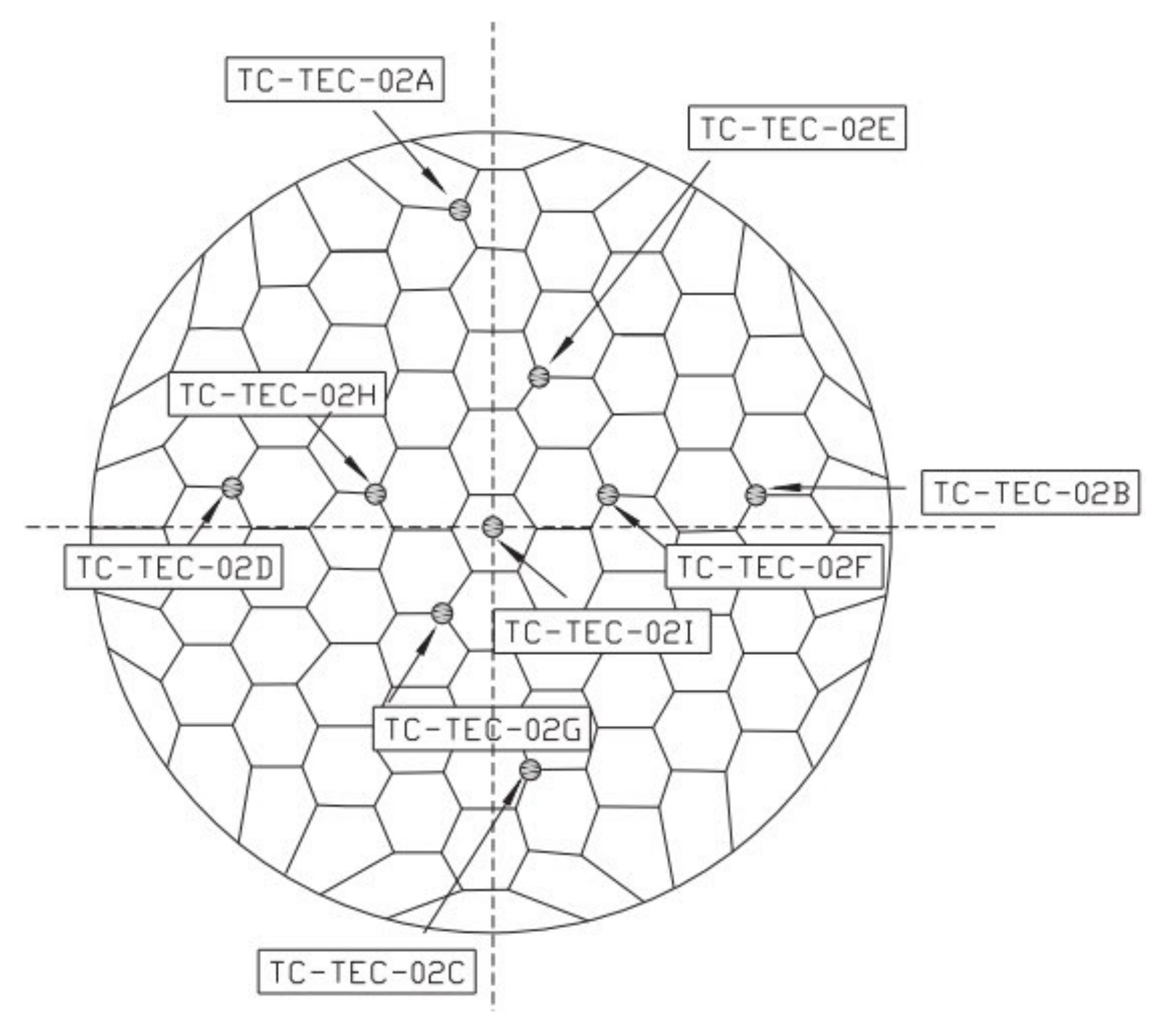Non-Uniform Temperature Fields and Effects of Steel Structures: Review and Outlook
Abstract
1. Introduction
2. Previous Studies
2.1. Space Structures
2.2. Bridges
2.3. Radio Telescopes
3. Research Method
3.1. Numerical Simulation
3.2. Experimental Test
4. Outlook
4.1. Accurate Simulation of Temperature Field
4.2. Improvement of Test Method
4.3. Other Aspects
5. Conclusions
Author Contributions
Funding
Conflicts of Interest
References
- Yu, Y.Q.; Zhu, F.Q.; Wang, Z. Review of the Promotion and Application of Steel Structures in Construction. Steel Constr. 2020, 35, 59–69. [Google Scholar]
- Liu, H.B.; Chen, Z.H.; Zhou, T. Investigation on temperature distribution and thermal behavior of large span structures considering solar radiation. Adv. Steel Constr. 2013, 9, 41–58. [Google Scholar]
- Chen, D.S.; Qian, H.L.; Wang, H.J.; Xu, W.C.; Li, J.F. Non-Uniform Temperature Field of Spatial Grid Structure under Construction Induced by Solar Radiation. Appl. Sci. 2020, 10, 2445. [Google Scholar] [CrossRef]
- Ministry of Housing and Urban-Rural Development of the People’s Republic of China. Load Code for the Design of Building Structures; GB50009-2012; China Architectural & Building Press: Beijing, China, 2012.
- Ministry of Housing and Urban-Rural Development of the People’s Republic of China. Code for Design of Steel Structures; GB50017-2003; China Architectural & Building Press: Beijing, China, 2003.
- Ministry of Housing and Urban-Rural Development of the People’s Republic of China. Technical Specification for Space Frame Structures; JGJ7-2010; China Architectural & Building Press: Beijing, China, 2010.
- Fan, Z. Key Techniques of Large-span Structure Design for Beijing National Stadium. J. Build. Struct. 2006, 36, 34–43. [Google Scholar]
- Chen, D.S.; Xu, W.C.; Qian, H.L.; Sun, J.Y.; Li, J.F. Effects of non-uniform temperature on closure construction of spatial truss structure. J. Build. Eng. 2020, 32, 101532. [Google Scholar] [CrossRef]
- Liu, H.B.; Chen, Z.H. Non-Uniform Temperature Effect of Large-Span Building Structure Considering Solar Radiation; Science Press: Beijing, China, 2016. [Google Scholar]
- Liu, H.B.; Zhang, Z.S.; Chen, Z.H.; Chen, Q. Research on temperature field and temperature effect of steel silos under solar radiation. J. Build. Struct. 2016, 37, 151–157. [Google Scholar]
- Liu, H.B.; Ying, J.J.; Chen, Z.Z. Study overviews of non-uniform thermal behavior of spatial structures under solar radiation. Build. Struct. 2017, 47, 59–63. [Google Scholar]
- Song, Y.S.; Ding, Y.L. Fatigue monitoring and analysis of orthotropic steel deck considering traffic volume and ambient temperature. Sci. China Technol. Sci. 2013, 56, 1758–1766. [Google Scholar] [CrossRef]
- Xia, Y.; Chen, B.; Wen, S.; Ni, Y.Q.; Xu, Y.L. Temperature effect on vibration properties of civil structures: A literature review and case studies. J. Civ. Struct. Health Monit. 2012, 2, 29–46. [Google Scholar] [CrossRef]
- Schindler, A.K.; Hughes, M.L.; Barnes, R.W.; Byard, B.E. Evaluation of cracking of the US 331 bridge deck. In Research Report, Highway Research Center, 238 Harbert Engineering Center; Auburn University: Auburn, AL, USA, 2010. [Google Scholar]
- Jin, X.F. Study of Key Issues of the Structural Safety and Accuracy Control of the Five-Hundred-Meter Aperture Radio Telescope. Ph.D. Thesis, Harbin Institute of Technology, Harbin, China, 2010. [Google Scholar]
- Alinia, M.M.; Kashizadeh, S. Effects of support positioning on thermal behaviour of double layer space truss domes. J. Constr. Steel Res. 2007, 63, 375–382. [Google Scholar] [CrossRef]
- Alinia, M.M.; Kashizadeh, S. Effect of flexibility of substructures upon thermal behaviour of spherical double layer space truss domes. Part I: Uniform thermal loading. J. Constr. Steel Res. 2006, 62, 359–368. [Google Scholar] [CrossRef]
- Alinia, M.M.; Kashizadeh, S. Effect of flexibility of substructures upon thermal behaviour of spherical double layer space truss domes. Part II: Gradient & partial loading. J. Constr. Steel Res. 2006, 62, 675–681. [Google Scholar] [CrossRef]
- Liu, H.B. Study on the Construction Control Theory and Temperature Effect of Suspen-Dome Structure. Ph.D. Thesis, Tianjin University, Tianjin, China, 2011. [Google Scholar]
- Liu, H.B.; Chen, Z.H.; Zhou, T. Numerical and experimental investigation on the temperature distribution of steel tubes under solar radiation. Struct. Eng. Mech. 2012, 43, 725–737. [Google Scholar] [CrossRef]
- Wang, Y.Q.; Lin, C.C.; Shi, Y.J. Experimental study on the temperature of steel members in sunshine. J. Build. Struct. 2010, 31, 140–147. [Google Scholar]
- Chen, D.S.; Qian, H.L.; Wang, H.J.; Chen, Y.; Fan, F.; Shen, S.Z. Experimental and numerical investigation on the non-uniform temperature distribution of thin-walled steel members under solar radiation. Thin Walled Struct. 2018, 122, 242–251. [Google Scholar] [CrossRef]
- Chen, D.S. Experimental and Numerical Investigation of the Non-Uniform Temperature Field and the Effect on Spatial Steel Structures under Solar Radiation. Ph.D. Thesis, Harbin Institute of Technology, Harbin, China, 2017. [Google Scholar]
- Liu, H.B.; Chen, Z.H.; Chen, B.B.; Xiao, X.; Wang, X.D. Studies on the temperature distribution of steel plates with different paints under solar radiation. Appl. Therm. Eng. 2014, 71, 342–354. [Google Scholar] [CrossRef]
- Chen, D.S.; Wang, H.J.; Qian, H.L.; Li, X.Y.; Fan, F.; Shen, S.Z. Experimental and numerical investigation of temperature effects on steel members due to solar radiation. Appl. Therm. Eng. 2017, 127, 696–704. [Google Scholar] [CrossRef]
- Zhao, Z.W. Researches on Erection Simulation Optimization and Thermal Effect of Large-Span Double-Helix Single-Layer Latticed Shell Structure. Ph.D. Thesis, Tianjin University, Tianjin, China, 2016. [Google Scholar]
- Zhao, Z.W.; Liu, H.B.; Chen, Z.H. Field monitoring and numerical analysis of thermal behavior of large span steel structures under solar radiation. Adv. Steel Constr. 2017, 13, 190–205. [Google Scholar]
- Liu, H.B.; Li, B.; Chen, Z.H.; Zhou, T.; Zhang, Q. Solar radiation properties of common membrane roofs used in building structures. Mater. Des. 2016, 105, 268–277. [Google Scholar] [CrossRef]
- Liu, H.B.; Liao, X.W.; Chen, Z.H.; Zhang, Q. Thermal behavior of spatial structures under solar irradiation. Appl. Therm. Eng. 2015, 87, 328–335. [Google Scholar] [CrossRef]
- Luo, Y.Z.; Mei, Y.J.; Shen, Y.B.; Yang, P.C.; Jin, L.; Zhang, P.F. Field measurement of temperature and stress on steel structure of the National Stadium and analysis of temperature action. J. Build. Struct. 2013, 34, 24–32. [Google Scholar]
- Pei, Y.; Bai, Y.; Shi, Y.; Zhu, D.; Wang, Y. Temperature distribution in a long-span aircraft hangar. Tsinghua Sci. Technol. 2008, 13, 184–190. [Google Scholar] [CrossRef]
- Zhou, M.; Fan, J.S.; Liu, Y.F.; Zhang, J.X.; Duan, X.J.; Lei, S.S. Non-uniform temperature field and effect on construction of large-span steel structures. Autom. Constr. 2020, 119, 103339. [Google Scholar] [CrossRef]
- Liu, H.B.; Chen, Z.H.; Zhou, T. Temperature distribution and structural behavior of box-sectional arch structures under solar radiation. Adv. Steel Constr. 2013, 9, 298–308. [Google Scholar] [CrossRef]
- Liu, H.B.; Chen, Z.H.; Han, Q.H.; Chen, B.B.; Bu, Y.D. Study on the thermal behavior of aluminum reticulated shell structures considering solar radiation. Thin Walled Struct. 2014, 85, 15–24. [Google Scholar] [CrossRef]
- Liu, H.B.; Chen, Z.H.; Zhou, T. Research on the Process of Pre-Stressing Construction of Suspen-Dome Considering Temperature Effect. Adv. Struct. Eng. 2012, 15, 489–493. [Google Scholar] [CrossRef]
- Liu, H.B.; Chen, Z.H. Non-Uniform Thermal Behaviour of Suspen-Dome with Stacked Arch Structures. Adv. Struct. Eng. 2013, 16, 1001–1009. [Google Scholar] [CrossRef]
- China Association for Engineering Construction Standardization. Technical Specification for Retractable Roof Structures; CECS 417:2015; China Planning Press: Beijing, China, 2015. [Google Scholar]
- Ministry of Housing and Urban-Rural Development of the People’s Republic of China. Technical Standard for Retractable Roof Structures; JGJ/T 442-2019; China Architectural & Building Press: Beijing, China, 2019.
- Liu, Y.; Qian, Z.D.; Hu, H.Z. Thermal field characteristic analysis of steel bridge deck during high-temperature asphalt pavement paving. KSCE J. Civ. Eng. 2016, 20, 2811–2821. [Google Scholar] [CrossRef]
- Wang, D.; Liu, Y.M.; Liu, Y. 3D temperature gradient effect on a steel-concrete composite deck in a suspension bridge with field monitoring data. Struct. Control Health Monit. 2018, 25, e2179. [Google Scholar] [CrossRef]
- Liu, W.S.; Dai, G.L.; Rao, S.C. Numerical calculation on solar temperature field of a cable-stayed bridge with U-shaped section on high-speed railway. J. Cent. South Univ. 2014, 21, 3345–3352. [Google Scholar] [CrossRef]
- Wang, J.F.; Zhang, J.T.; Xu, R.Q.; Yang, Z.X. Evaluation of Thermal Effects on Cable Forces of a Long-Span Prestressed Concrete Cable-Stayed Bridge. J. Perform. Constr. Facil. 2019, 33, 04019072. [Google Scholar] [CrossRef]
- Wang, G.X.; Ding, Y.L.; Liu, X.W. The monitoring of temperature differences between steel truss members in long-span truss bridges compared with bridge design codes. Adv. Struct. Eng. 2019, 22, 1453–1466. [Google Scholar] [CrossRef]
- Wang, G.X.; Ding, Y.L. Research on monitoring temperature difference from cross sections of steel truss arch girder of Dashengguan Yangtze Bridge. Int. J. Steel Struct. 2015, 15, 647–660. [Google Scholar] [CrossRef]
- Wang, G.X.; Ding, Y.L.; Sun, P.; Wu, L.L.; Yue, Q. Assessing Static Performance of the Dashengguan Yangtze Bridge by Monitoring the Correlation between Temperature Field and Its Static Strains. Math. Probl. Eng. 2015, 2015, 12. [Google Scholar] [CrossRef]
- State Railway Administration. Code for Design on Railway Bridge and Culvert; TB 10002-2017; China Railway Publishing House: Beijing, China, 2017.
- Wang, G.X.; Ding, Y.L. Long-Term Monitoring of Temperature Effect on Horizontal Rotation Angle at Beam Ends of a Railway Steel Truss Bridge. J. Bridge Eng. 2019, 24, 05019012. [Google Scholar] [CrossRef]
- Wang, G.X.; Ding, Y.L. Reliability Estimation of Horizontal Rotation at Beam End of Long-Span Continuous Truss Bridge Affected by Temperature Gradients. J. Perform. Constr. Facil. 2019, 33, 04019061. [Google Scholar] [CrossRef]
- Ding, Y.L.; Zhou, G.D.; Li, A.Q.; Wang, G.X. Thermal Field Characteristic Analysis of Steel Box Girder Based on Long-term Measurement Data. Int. J. Steel Struct. 2012, 12, 219–232. [Google Scholar] [CrossRef]
- European Committee for Standardization. Eurocode 1: Actions on Structures-Part 1–5: General Actions-Thermal Actions; BS EN 1991-1-5: 2003; European Committee for Standardization: Brussels, Belgium, 2003. [Google Scholar]
- Lucas, J.M.; Virlogeux, M.; Louis, C. Temperature in the Box Girder of the Normandy Bridge. Struct. Eng. Int. 2005, 15, 156–165. [Google Scholar] [CrossRef]
- Lucas, J.M.; Berred, A.; Louis, C. Thermal actions on a steel box girder bridge. Proc. Inst. Civ. Eng. Struct. Build. 2003, 156, 175–182. [Google Scholar] [CrossRef]
- Tong, M.; Tham, L.G.; Au, F.T.K. Extreme thermal loading on steel bridges in tropical region. J. Bridge Eng. 2002, 7, 357–366. [Google Scholar] [CrossRef]
- Au, F.T.K.; Tham, L.G.; Tong, M. Design thermal loading for steel bridges in Hong Kong. HKIE Trans. 2001, 8, 1–9. [Google Scholar] [CrossRef]
- Miao, C.Q.; Shi, C.H. Temperature gradient and its effect on flat steel box girder of long-span suspension bridge. Sci. China Technol. Sci. 2013, 56, 1929–1939. [Google Scholar] [CrossRef]
- Zhou, L.R.; Xia, Y.; Brownjohn, J.M.W.; Koo, K.Y. Temperature Analysis of a Long-Span Suspension Bridge Based on Field Monitoring and Numerical Simulation. J. Bridge Eng. 2016, 21, 04015027. [Google Scholar] [CrossRef]
- Ding, Y.L.; Wang, G.X. Estimating extreme temperature differences in steel box girder using long-term measurement data. J. Cent. South Univ. 2013, 20, 2537–2545. [Google Scholar] [CrossRef]
- Park, S.J.; Kim, Y.G.; Kim, S.H. A study on Temperature variation of Steel box girder for construction of Key-segment Closure of Partially Earth-anchored Cable-stayed Bridges. In Proceedings of the 6th International Conference on Bridge Maintenance, Safety and Management (IABMAS), Stresa, Italy, 8–12 July 2012; pp. 3638–3642. [Google Scholar]
- Wang, J.F.; Xu, Z.Y.; Fan, X.L.; Lin, J.P. Thermal Effects on Curved Steel Box Girder Bridges and Their Countermeasures. J. Perform. Constr. Facil. 2017, 31, 04016091. [Google Scholar] [CrossRef]
- Xia, Y.; Chen, B.; Zhou, X.Q.; Xu, Y.L. Field monitoring and numerical analysis of Tsing Ma Suspension Bridge temperature behavior. Struct. Control Health Monit. 2013, 20, 560–575. [Google Scholar] [CrossRef]
- Xu, Y.L.; Chen, B.; Ng, C.L.; Wong, K.Y.; Chan, W.Y. Monitoring temperature effect on a long suspension bridge. Struct. Control Health Monit. 2010, 17, 632–653. [Google Scholar] [CrossRef]
- Zhou, Y.; Sun, L.M. A comprehensive study of the thermal response of a long-span cable-stayed bridge: From monitoring phenomena to underlying mechanisms. Mech. Syst. Signal Proc. 2019, 124, 330–348. [Google Scholar] [CrossRef]
- Yang, D.H.; Yi, T.H.; Li, H.N.; Zhang, Y.F. Monitoring and analysis of thermal effect on tower displacement in cable-stayed bridge. Measurement 2018, 115, 249–257. [Google Scholar] [CrossRef]
- Zhang, G. Experimental Research on Sunshine Non-Uniform Temperature Field of Radio Telescope. Master’s Thesis, Harbin Institute of Technology, Harbin, China, 2015. [Google Scholar]
- Hessels, J. X marks the spot for fast radio bursts. Nature 2019, 572, 320–321. [Google Scholar] [CrossRef]
- Ransom, S.M.; Hessels, J.W.T.; Stairs, I.H.; Freire, P.C.C.; Camilo, F.; Kaspi, V.M.; Kaplan, D.L. Twenty-one millisecond pulsars in Terzan 5 using the Green Bank Telescope. Science 2005, 307, 892–896. [Google Scholar] [CrossRef] [PubMed]
- Greve, A.; Kaercher, H.J. Performance Improvement of a Flexible Telescope Through Metrology and Active Control. Proc. IEEE 2009, 97, 1412–1420. [Google Scholar] [CrossRef]
- Qian, H.L.; Liu, Y.; Fan, F.; Fu, L.; Liu, G.X. Analysis of the Precision of the Structural Performance of the 5 m-Antenna Reflector. Int. J. Space Struct. 2013, 28, 15–26. [Google Scholar] [CrossRef]
- Nan, R.D.; Li, D.; Jin, C.J.; Wang, Q.M.; Zhu, L.C.; Zhu, W.B.; Zhang, H.Y.; Yue, Y.L.; Qian, L. The Five-hundred-meter Aperture Spherical Radio Telescope (FAST) Project. Int. J. Mod. Phys. D 2011, 20, 989–1024. [Google Scholar] [CrossRef]
- Kildal, P.S.; Baker, L.A.; Hagfors, T. The Arecibo Upgrading: Electrical Design and Expected Performance of the Dual-Reflector Feed System. Proc. IEEE 1994, 82, 714–724. [Google Scholar] [CrossRef]
- Shen, S.Z.; Fan, F.; Qian, H.L. Research on support structure scheme for active reflector of FAST. J. Build. Struct. 2010, 31, 1–8. [Google Scholar]
- Wang, Q.M.; Zhu, M.; Wang, Q.M.; Yang, L.; Lei, Z. The Monitoring of Temperature Effect on the Supporting Structure of Main Active Reflector for FAST. In Proceedings of the 2nd International Conference on Mechanics, Materials and Structural Engineering (ICMMSE), Beijing, China, 14–16 April 2017; pp. 201–207. [Google Scholar]
- Fan, F.; Jin, X.F.; Shen, S.Z. Effect of Non-uniform Solar Temperature Field on Cable-net Structure of Reflector of Large Radio Telescope-FAST. Adv. Struct. Eng. 2009, 12, 503–512. [Google Scholar] [CrossRef]
- Jin, X.F.; Fan, F.; Shen, S.Z. Effect of non-uniform temperature field under sunshine on the structure supporting the reflector of a large radio telescope-FAST. China Civ. Eng. J. 2008, 41, 71–77. [Google Scholar]
- Liu, Y. Non-uniform Solar Temperature Field on Large Aperture, Fully-Steerable Telescope Structure. J. Astrophys. Astron. 2016, 37, 19. [Google Scholar] [CrossRef]
- Greve, A.; MacLeod, G. Thermal model calculations of enclosures for millimeter wavelength radio telescopes. Radio Sci. 2001, 36, 1111–1128. [Google Scholar] [CrossRef]
- Greve, A.; Bremer, M. Calculated thermal behavior of ventilated high precision radio telescopes. IEEE Antennas Propag. Mag. 2006, 48, 9–19. [Google Scholar] [CrossRef]
- Bremer, M.; Greve, A. A dynamic thermal Model for Design and Control of an 800-Element Open-Air Radio Telescope. In Proceedings of the Conference on Integrated Modeling of Complex Optomechanical Systems, Kiruna, Sweden, 15–17 August 2011. 83360U. [Google Scholar]
- Greve, A.; Bremer, M. Thermal Design and Thermal Behavior of Radio Telescopes and Their Enclosures; Springer: Berlin, Germany, 2010. [Google Scholar]
- Qian, H.L.; Chen, D.S.; Fan, F.; Liu, Y.; Shen, S.Z. Evaluation of solar temperature field under different wind speeds for Shanghai 65 m radio telescope. Int. J. Steel Struct. 2016, 16, 383–393. [Google Scholar] [CrossRef]
- Zhong, J.; Qian, H.L.; Fan, F.; Shen, S.Z. An estimate of the time-varying temperature field of the main reflector and subreflector of the Shanghai 65 m radio telescope under solar illumination. Int. J. Steel Struct. 2016, 16, 115–124. [Google Scholar] [CrossRef]
- Fan, F. Mechanical analysis report on Shanghai 65 m radio telescope structure. In Research Report, Space Structure Research Center of Harbin Institute of Technology; Harbin Institute of Technology: Harbin, China, 2010. [Google Scholar]
- Qian, H.L.; Liu, Y.; Fan, F.; Fu, L.; Liu, G.X. The Analysis of Solar Radiation of Shanghai 65 m Radio Telescope. Eng. Mech. 2012, 29, 378–384. [Google Scholar] [CrossRef]
- Zhong, J. Research on Non-Uniform Temperature Field of Giant Radio Telescopes. Master’s Thesis, Harbin Institute of Technology, Harbin, China, 2012. [Google Scholar]
- Liu, G.X.; Zheng, Y.P. Report on design of Shanghai 65 m antenna structure. In Research Report, The 54th Research Institute of China Electronics Technology Group Corporation; China Electronics Technology Group: Shijiazhuang, China, 2009. [Google Scholar]
- Borovkov, A.; Shevchenko, D.V.; Gimmelman, V.G.; Machuev, Y.I.; Gaev, A.V. Finite-element modeling and thermal analysis of the RT-70 radio telescope main reflector. In Proceedings of the 4th International Conference on Antenna Theory and Techniques, Sevastopol, Ukraine, 9–12 September 2003; pp. 651–654. [Google Scholar]
- Prestage, R.M.; Constantikes, K.T.; Balser, D.S.; Condon, J.J. The GBT Precision Telescope Control System. In Proceedings of the Conference on Ground-Based Telescopes, Glasgow, UK, 21–25 June 2004; pp. 1029–1040. [Google Scholar]
- Ukita, N. Thermal effects on the pointing of the Nobeyama 45-m telescope. Publ. Natl. Astron. Obs. Jpn. 1999, 5, 139–147. [Google Scholar]
- Akabane, K. A large millimeter wave antenna. Int. J. Infrared Millim. Waves 1983, 4, 793–808. [Google Scholar] [CrossRef]
- Nindos, A.; Kontar, E.P.; Oberoi, D. Solar physics with the Square Kilometre Array. Adv. Space Res. 2019, 63, 1404–1424. [Google Scholar] [CrossRef]
- Corder, S.; Cox, P. Atacama large millimeter/submillimeter array: Progress, status, and development. In Proceedings of the Conference on Ground-Based and Airborne Telescopes V, Montreal, QC, Canada, 22–27 June 2014. 91451V. [Google Scholar]
- Chen, D.S.; Qian, H.L.; Wang, H.J.; Zhang, G.; Fan, F.; Shen, S.Z. Non-uniform temperature field measurement and simulation of a radio telescope’s main reflector under solar radiation. Appl. Therm. Eng. 2017, 111, 1330–1341. [Google Scholar] [CrossRef]
- Chen, D.S.; Wang, H.J.; Qian, H.L.; Zhang, G.; Shen, S.Z. Solar cooker effect test and temperature field simulation of radio telescope subreflector. Appl. Therm. Eng. 2016, 109, 147–154. [Google Scholar] [CrossRef]
- Qian, H.L.; Liu, Y.; Fan, F.; Jin, X.F. Non-uniform temperature field and effects of Shanghai 65 m radio telescope. Opt. Precis. Eng. 2014, 22, 970–978. [Google Scholar] [CrossRef]
- McQuiston, F.C.; Parker, J.D.; Spitler, J.D. Heating, Ventilating and Air Conditioning: Analysis and Design, 6th ed.; John Wiley and Sons, Inc.: Hoboken, NJ, USA, 2005. [Google Scholar]
- Moon, P. Proposed standard solar radiation curves for engineering use. J. Frankl. Inst. 1940, 230, 583–617. [Google Scholar] [CrossRef]
- Threlkeld, J.L.; Jordan, R.C. Direct solar radiation available on clear days. ASHARE Trans. 1958, 64, 45–48. [Google Scholar]
- American Society of Heating, Refrigeration, and Air-Conditioning Engineers. ASHRAE Handbook of Fundamentals; American Society of Heating, Refrigeration, and Air-Conditioning Engineers: Atlanta, GA, USA, 1972. [Google Scholar]
- Hottel, H.C. A simple model for estimating the transmittance of direct solar radiation through clear atmospheres. Sol. Energy. 1976, 18, 129–134. [Google Scholar] [CrossRef]
- Liu, B.Y.H.; Jordan, R.C. The interrelationship and characteristic distribution of direct, diffuse and total solar radiation. Sol. Energy. 1960, 4, 1–19. [Google Scholar] [CrossRef]
- Kehlbeck, F. Effect of Solar Radiation on Bridge Structure; Liu, X.F., Translator; Chinese Railway Publishing Company: Beijing, China, 1981. [Google Scholar]
- Dilger, W.H.; Ghali, A.; Chan, M.; Cheung, M.S.; Maes, M.A. Temperature stresses in composite box girder bridges. J. Struct. Eng. 1990, 109, 1460–1478. [Google Scholar] [CrossRef]
- Elbadry, M.M.; Ghali, A. Temperature Variations in Concrete Bridges. J. Struct. Eng. 1983, 109, 2355–2374. [Google Scholar] [CrossRef]
- Chen, Q. Effects of Thermal Actions on Texas Steel Bridges. Ph.D. Thesis, University of Texas at Austin, Austin, TX, USA, 2008. [Google Scholar]
- Zhou, M.; Fan, J.S.; Liu, Y.F.; Zhang, J.X.; Duan, X.J.; Lei, S.S. Analysis on non-uniform temperature field of steel girds of Beijing Daxing International Airport terminal building core area considering solar radiation. Eng. Mech. 2020, 37, 46–54. [Google Scholar]
- Zhu, J.; Meng, Q. Effective and fine analysis for temperature effect of bridges in natural environments. J. Bridge Eng. 2017, 22, 04017017. [Google Scholar] [CrossRef]
- Yin, G.S.; Zhao, Z.Y.; Xu, B. Research on temperature field of arch bridge under solar radiation. Chin. J. Appl. Mech. 2014, 31, 939–944. [Google Scholar]
- Chen, Z.; Jin, F.; Wang, J.T. Ray-tracing algorithm for solar radiation intensity computation of arch dam surface. J. Hydraul. Eng. 2007, 38, 1461–1465. [Google Scholar]
- Gohen, M.F.; Greenberg, D.P. The hemi-cube: A radiosity solution for complex environments. ACM Siggraph Comput. Graph. 1985, 19, 31–40. [Google Scholar] [CrossRef]
- Xu, F.; Wang, B.; Zhang, H.L. Improvement upon the formulas for solar position in analysis of sunlight distribution in buildings. J. Chongqing Jianzhu Univ. 2008, 30, 130–134. [Google Scholar]
- Gao, F.; Chen, P.; Xia, Y.; Zhu, H.P.; Weng, S. Efficient calculation and monitoring of temperature actions on supertall structures. Eng. Struct. 2019, 193, 1–11. [Google Scholar] [CrossRef]
- Duffie, J.A.; Beckman, W.A. Solar Engineering of Thermal Processes; John Wiley and Sons Inc.: New York, NY, USA, 1980. [Google Scholar]
- Liu, N.X.; Qin, Y.G. Building Thermal Environment; Tsinghua University Press: Beijing, China, 2005. [Google Scholar]
- Lee, J.H. Investigation of Extreme Environmental Conditions and Design Thermal Gradients during Construction for Prestressed Concrete Bridge Girders. J. Bridge Eng. 2012, 17, 547–556. [Google Scholar] [CrossRef]
- Wei, G.P. Research for temperature fields and temperature stresses of prestressed concrete single-box girder bridge. J. Southwest Jiaotong Univ. 1989, 24, 90–97. [Google Scholar]
- Riding, K.A.; Poole, J.L.; Schindler, A.K.; Juenger, M.C.G.; Folliard, K.J. Temperature boundary condition models for concrete bridge members. ACI Mater. J. 2007, 104, 379–387. [Google Scholar]
- Chen, B.B. Study on Heterogeneous Temperature Effect of Large Span Structures under Solar Radiation. Master’s Thesis, Tianjin University, Tianjin, China, 2013. [Google Scholar]
- Liu, H.B.; Chen, Z.H.; Zhou, T. Theoretical and experimental study on the temperature distribution of H-shaped steel members under solar radiation. Appl. Therm. Eng. 2012, 37, 329–335. [Google Scholar] [CrossRef]
- Zhao, Z.W.; Liu, H.B.; Chen, Z.H. Thermal behavior of large-span reticulated domes covered by ETFE membrane roofs under solar radiation. Thin Walled Struct. 2017, 115, 1–11. [Google Scholar] [CrossRef]
- Xu, Y.L.; Xia, Y. Structural Health Monitoring of Long-Span Suspension Bridges; Spon Press: London, UK, 2011. [Google Scholar]
- Dilger, W.H. Temperature effects in concrete and composite bridges. In Proceedings of the Workshop on Research and Monitoring of Long Span Bridges, Hong Kong, China; 26–28 April 2000; pp. 1–13. [Google Scholar]
- Froli, M.; Hariga, N.; Nati, G.; Orlandini, M. Longitudinal Thermal Behaviour of a Concrete Box Girder Bridge. Struct. Eng. Int. 1996, 6, 237–242. [Google Scholar] [CrossRef]
- Kim, S.H.; Park, S.J.; Wu, J.; Won, J.H. Temperature variation in steel box girders of cable-stayed bridges during construction. J. Constr. Steel Res. 2015, 112, 80–92. [Google Scholar] [CrossRef]
- Wang, G.X.; Ding, Y.L.; Wang, X.J.; Yan, X.; Zhang, Y.F. Long-term monitoring and statistical analysis of temperature field of flat steel-box girder of Sutong bridge. J. Highw. Transp. Res. Dev. 2014, 31, 69–73. [Google Scholar]
- Liu, Y.; Zhang, H.P.; Deng, Y.; Jiang, N.; Zhang, J.R. Temperature field characteristic research of steel box girder for suspension bridge based on measured data. China J. Highw. Transp. 2017, 30, 56–64. [Google Scholar]
- Ding, Y.L.; Wang, G.X.; Zhou, G.D.; Li, A.Q. Life-cycle simulation method of temperature field of steel box girder for Runyang Cable-stayed Bridge based on field monitoring data. China J. Civ. Eng. 2013, 46, 129–136. [Google Scholar]
- Greve, A.; Mangum, J. Mechanical measurements of the ALMA prototype antennas. IEEE Antennas Propag. Mag. 2008, 50, 66–80. [Google Scholar] [CrossRef]
- Bremer, M.; Penalver, J. FE model-based interpretation of telescope temperature variations. Proc. SPIE 2002, 4757, 186–195. [Google Scholar] [CrossRef]
- Greve, A.; Bremer, M.; Penalver, J.; Raffin, P.; Morris, D. Improvement of the IRAM 30-m telescope from temperature measurements and finite-element calculations. IEEE Trans. Antennas Propag. 2005, 53, 851–860. [Google Scholar] [CrossRef]
- Ukita, N.; Ezawa, H.; Ikenoue, B.; Saito, M. Thermal and wind effects on the azimuth axis tilt of the ASTE 10-m antenna. Publ. Nat. Astron. Obs. Jpn. 2007, 10, 25–33. [Google Scholar]
- Ukita, N.; Saito, M.; Ezawa, H.; Ikenoue, B.; Ishizaki, H.; Iwashita, H.; Yamaguchi, N.; Hayakawa, T. Design and performance of the ALMA-J prototype antenna. In Proceedings of the Society of Photo-Optical Instrumentation Engineers, Glasgow, UK, 21–25 June 2004; pp. 1085–1093. [Google Scholar]
- Schroeder, D.J. Astronomical Optics; Academic Press: San Diego, CA, USA, 1987. [Google Scholar]
- Machuyev, Y.I.; Gimmelman, V.G. Temperature state of radio antennas under climatic influences. In Proceedings of the 7th International Symposium on Antennas, Propagation and EM Theory, Guilin, China, 26–29 October 2006; pp. 545–548. [Google Scholar]
- Wang, G.X.; Ye, J.H. Localization and quantification of partial cable damage in the long-span cable-stayed bridge using the abnormal variation of temperature-induced girder deflection. Struct. Control Health Monit. 2019, 26, e2281. [Google Scholar] [CrossRef]
- Chen, Z.H.; Chen, B.B.; Liu, H.B. Experimental research on solar radiation absorptance of commonly used coatings for steel structures. J. Build. Struct. 2014, 35, 81–87. [Google Scholar]
- China Architectural & Building Press. Code for Thermal Design of Civil Building; GB 50176-2016; China Architectural & Building Press: Beijing, China, 2016. [Google Scholar]
- Xiao, X. Experimental and Numerical Study on Temperature of Steel Members and Single-Layer Lattice Shell Considering Coupling of Radiation, Thermal and Fluid. Master’s Thesis, Tianjin University, Tianjin, China, 2014. [Google Scholar]
- Liu, Y.J.; Liu, J.; Zhang, N. Review on solar thermal actions of bridge structures. China J. Civ. Eng. 2019, 52, 59–78. [Google Scholar]
- Yang, L.; Yang, Z. Principle and Technology of Temperature Measurement by Infrared Thermography; Science Press: Beijing, China, 2012. [Google Scholar]
- Xing, S.X. Infrared Thermal Imaging and Signal Processing; National Defence Industrial Press: Beijing, China, 2011.
- Ring, E.F.J.; Ammer, K. Infrared thermal imaging in medicine. Physiol. Meas. 2012, 33, R33–R46. [Google Scholar] [CrossRef] [PubMed]
- Bernard, V.; Can, V.; Staffa, E.; Farkasova, M.; Nemcova, M.; Dostal, M.; Kala, Z.; Mornstein, V. Infrared thermal imaging: A potential tool used in open colorectal surgery. Minerva Chir. 2017, 72, 442–446. [Google Scholar] [PubMed]
- Engert, V.; Merla, A.; Grant, J.A.; Cardone, D.; Tusche, A.; Singer, T. Exploring the Use of Thermal Infrared Imaging in Human Stress Research. PLoS ONE 2014, 9, e90782. [Google Scholar] [CrossRef] [PubMed]
- Thanh, N.T.; Sahli, H.; Hao, D.N. Detection and characterization of buried landmines using infrared thermography. Inverse Probl. Sci. Eng. 2011, 19, 281–307. [Google Scholar] [CrossRef]
- Szymanik, B. Inverse Problem Solution in Landmines Detection Based on Active Thermography. Radioengineering 2014, 23, 1203–1207. [Google Scholar]
- Stepanic, J.; Malivovec, M.; Svaic, S.; Krstelj, V. Parameterisation of non-homogeneities in buried object detection by means of thermography. Infrared Phys. Technol. 2004, 45, 201–208. [Google Scholar] [CrossRef]
- Crupi, V.; Chiofalo, G.; Guglielmino, E. Using Infrared Thermography in Low-Cycle Fatigue Studies of Welded Joints. Weld. J. 2010, 89, 195S–200S. [Google Scholar]
- De Brito, J.P.; Henriquez, J.R. Infrared thermography applied for high-level current density identification over planar microwave circuit sectors. Infrared Phys. Technol. 2010, 53, 84–88. [Google Scholar] [CrossRef]
- Meola, C.; Carlomagno, G.M.; Giorleo, L. The use of infrared thermography for materials characterization. J. Mater. Process. Technol. 2004, 155, 1132–1137. [Google Scholar] [CrossRef]
- Cohen, Y.; Alchanatis, V.; Meron, M.; Saranga, Y.; Tsipris, J. Estimation of leaf water potential by thermal imagery and spatial analysis. J. Exp. Bot. 2005, 56, 1843–1852. [Google Scholar] [CrossRef]
- Jones, H.G.; Serraj, R.; Loveys, B.R.; Xiong, L.Z.; Wheaton, A.; Price, A.H. Thermal infrared imaging of crop canopies for the remote diagnosis and quantification of plant responses to water stress in the field. Funct. Plant Biol. 2009, 36, 978–989. [Google Scholar] [CrossRef] [PubMed]
- Lindenthal, M.; Steiner, U.; Dehne, H.W.; Oerke, E.C. Effect of downy mildew development on transpiration of cucumber leaves visualized by digital infrared thermography. Phytopathology 2005, 95, 233–240. [Google Scholar] [CrossRef] [PubMed]
- Barreira, E.; de Freitas, V.P. Evaluation of building materials using infrared thermography. Constr. Build. Mater. 2007, 21, 218–224. [Google Scholar] [CrossRef]
- Cheng, C.C.; Cheng, T.M.; Chiang, C.H. Defect detection of concrete structures using both infrared thermography and elastic waves. Autom. Constr. 2008, 18, 87–92. [Google Scholar] [CrossRef]
- Grinzato, E.; Vavilov, V.; Kauppinen, T. Quantitative infrared thermography in buildings. Energy Build. 1998, 29, 1–9. [Google Scholar] [CrossRef]
- American Association of State Highway and Transportation Officials. AASHTO LRFD Bridge Design Specifications; American Association of State Highway and Transportation Officials: Washington, DC, USA, 2017. [Google Scholar]
- China Communications Press. General Specifications for Design of Highway Bridges and Culverts; JTG D60-2015; China Communications Press: Beijing, China, 2015. [Google Scholar]
- British Standards Institution. Steel, Concrete and Composite Bridges-Part 2: Specification for Loads; BS 5400-2: 2006; British Standards Institution: London, UK, 2006. [Google Scholar]
- Intergovernmental Panel on Climate Change. Climate Change 2007: The Physical Science Basis; Cambridge University Press: Cambridge, UK, 2007. [Google Scholar]
- Intergovernmental Panel on Climate Change. Global Warming of 1.5 °C; Cambridge University Press: Cambridge, UK, 2018. [Google Scholar]
- Intergovernmental Panel on Climate Change. Climate Change 1995: The Science of Climate Change; Cambridge University Press: Cambridge, UK, 1996. [Google Scholar]
- World Meteorological Organization. The Global Climate in 2015–2019. Research Reports, World Meteorological Organization; World Meteorological Organization: Geneva, Switzerland, 2020. [Google Scholar]
- Fan, Z.; Wang, Z.; Tang, J. Analysis on temperature field and determination of temperature upon healing of large-span steel structure of the National Stadium. J. Build. Struct. 2007, 28, 32–40. [Google Scholar]
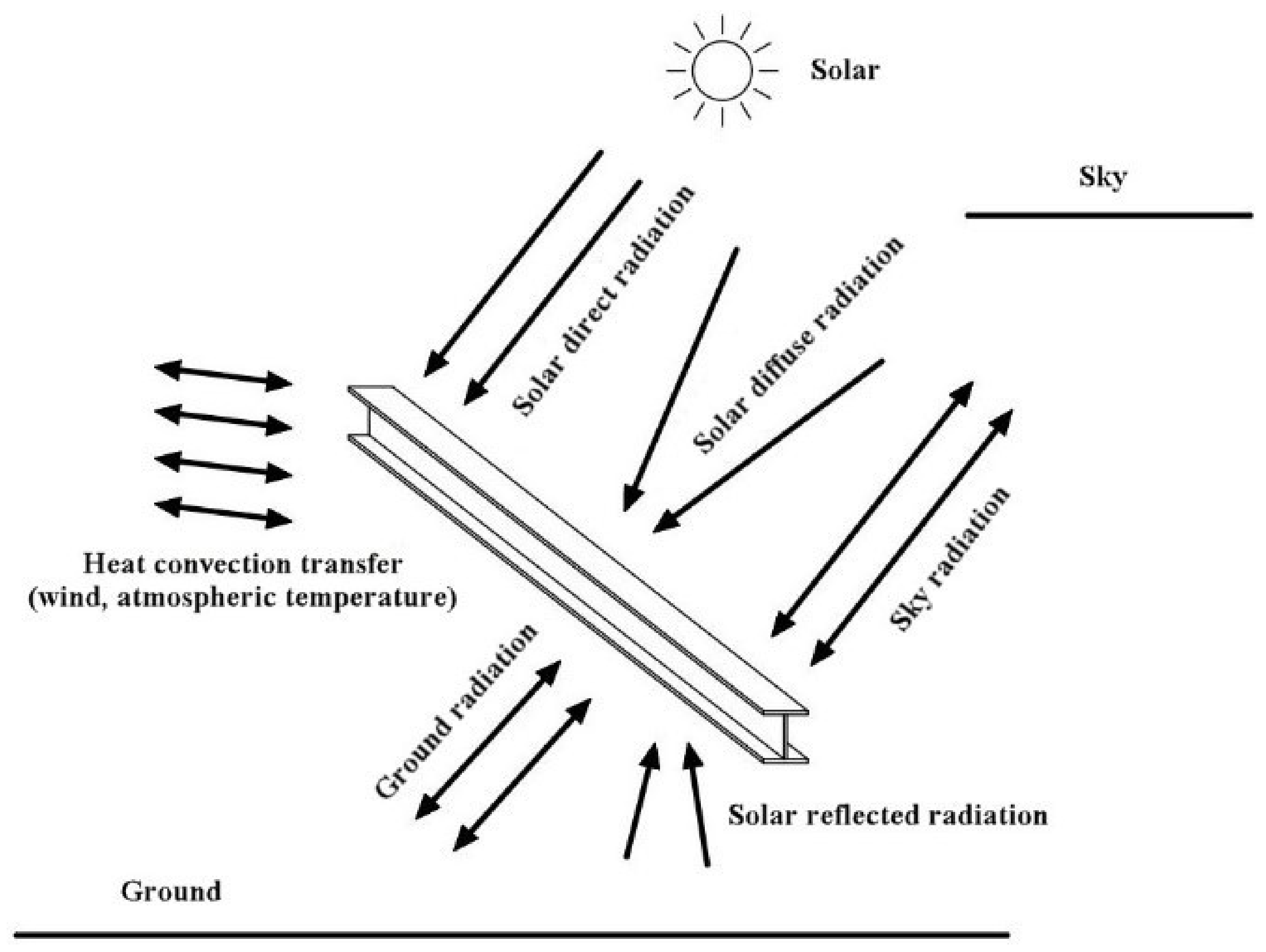
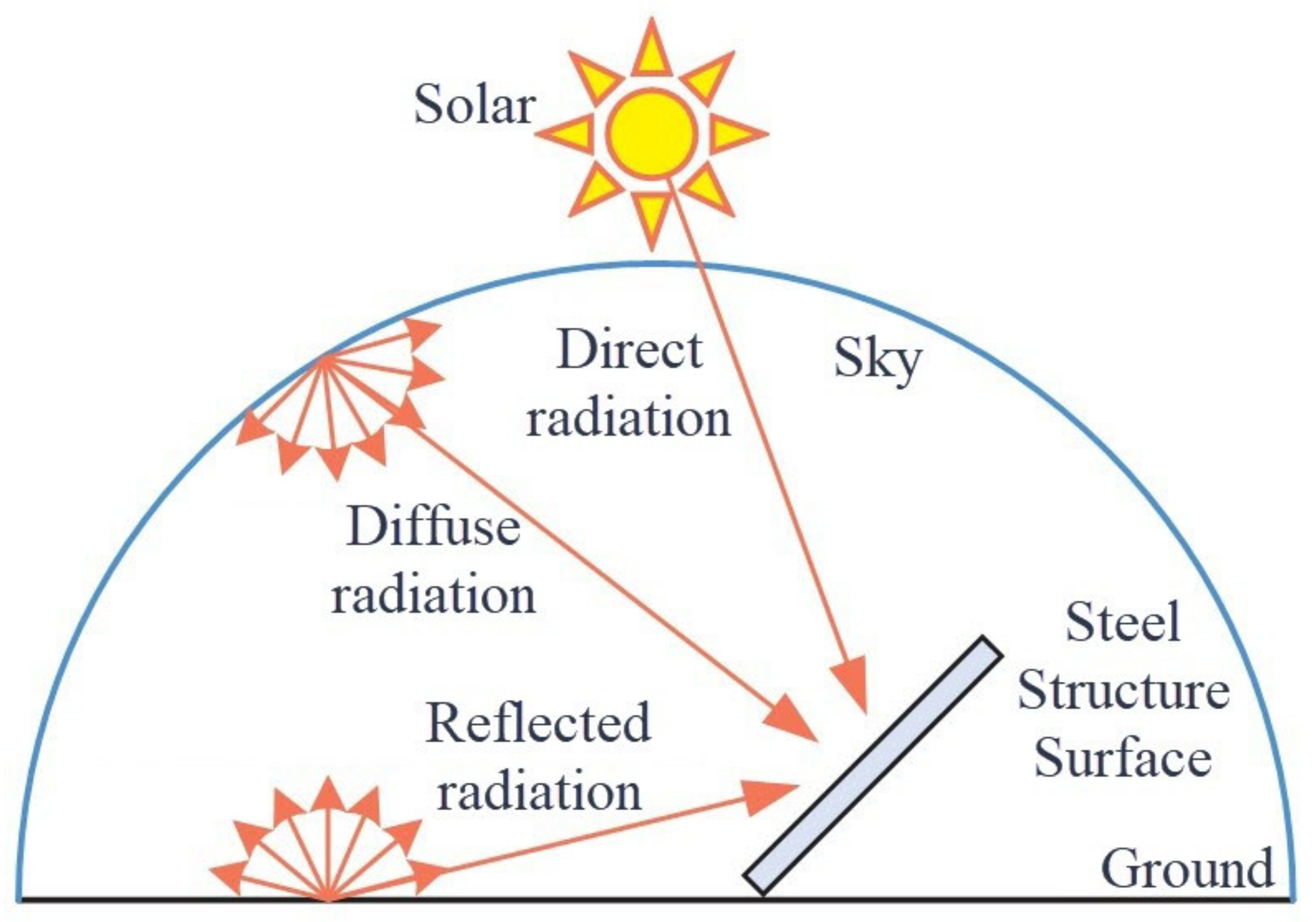
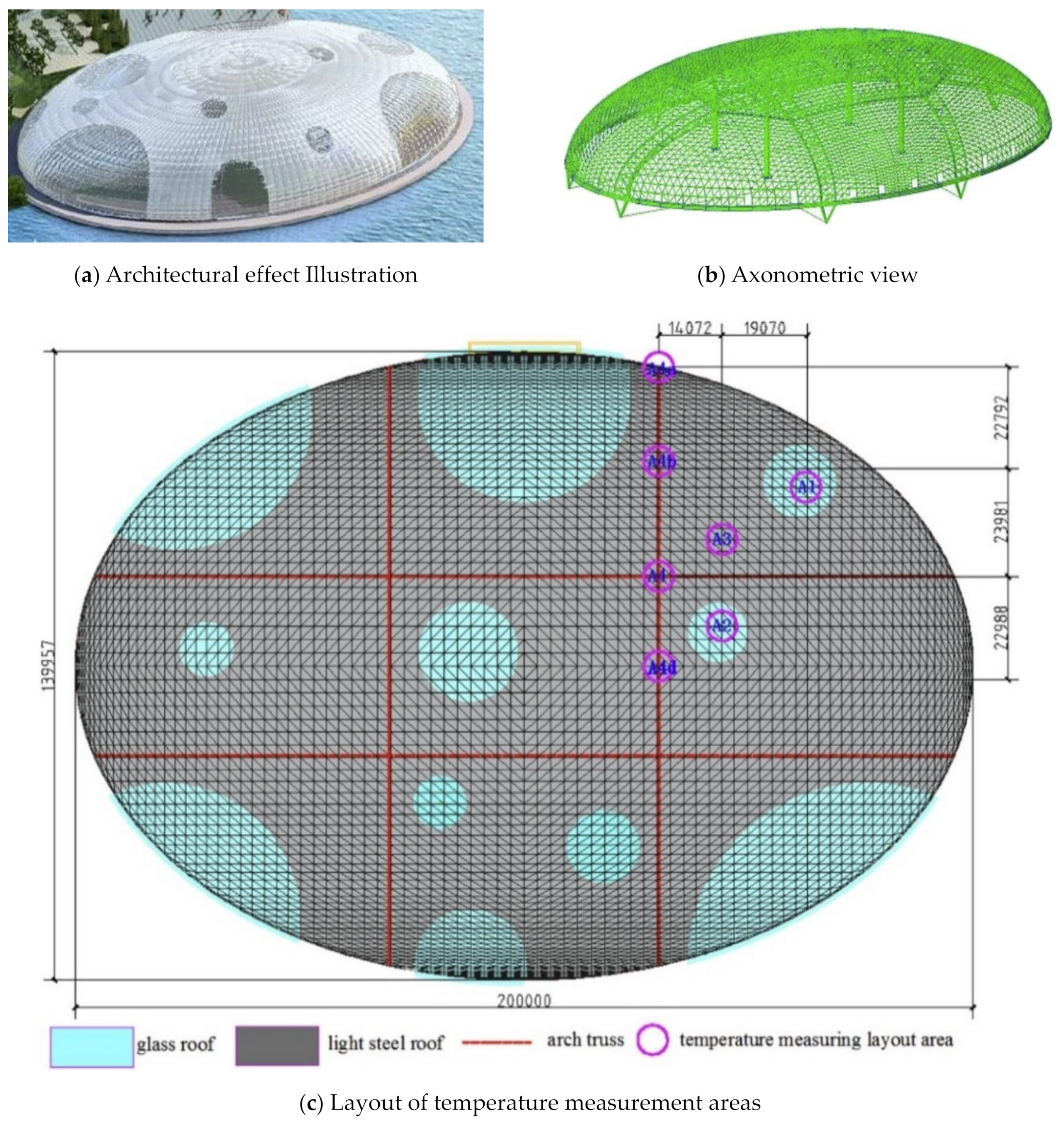
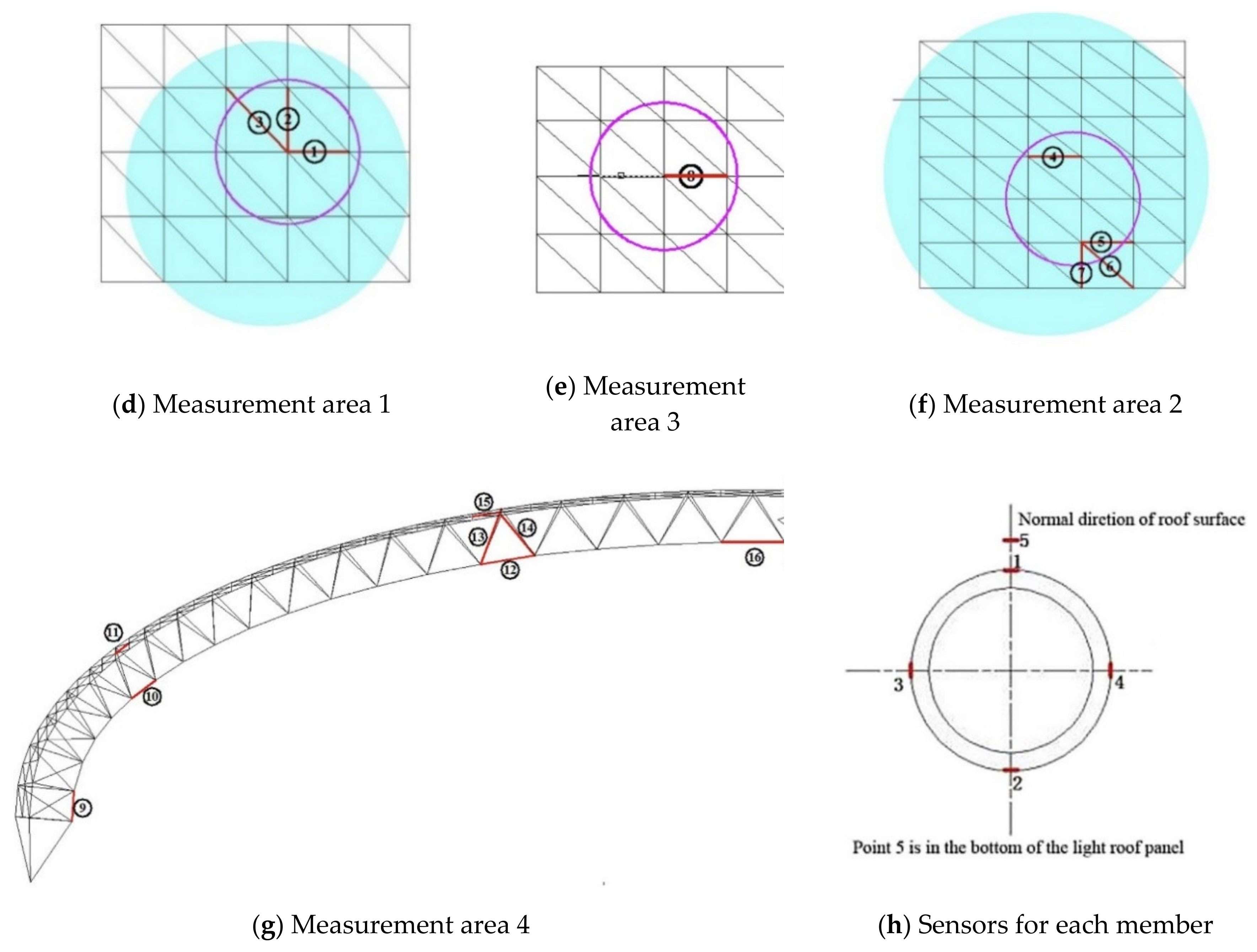

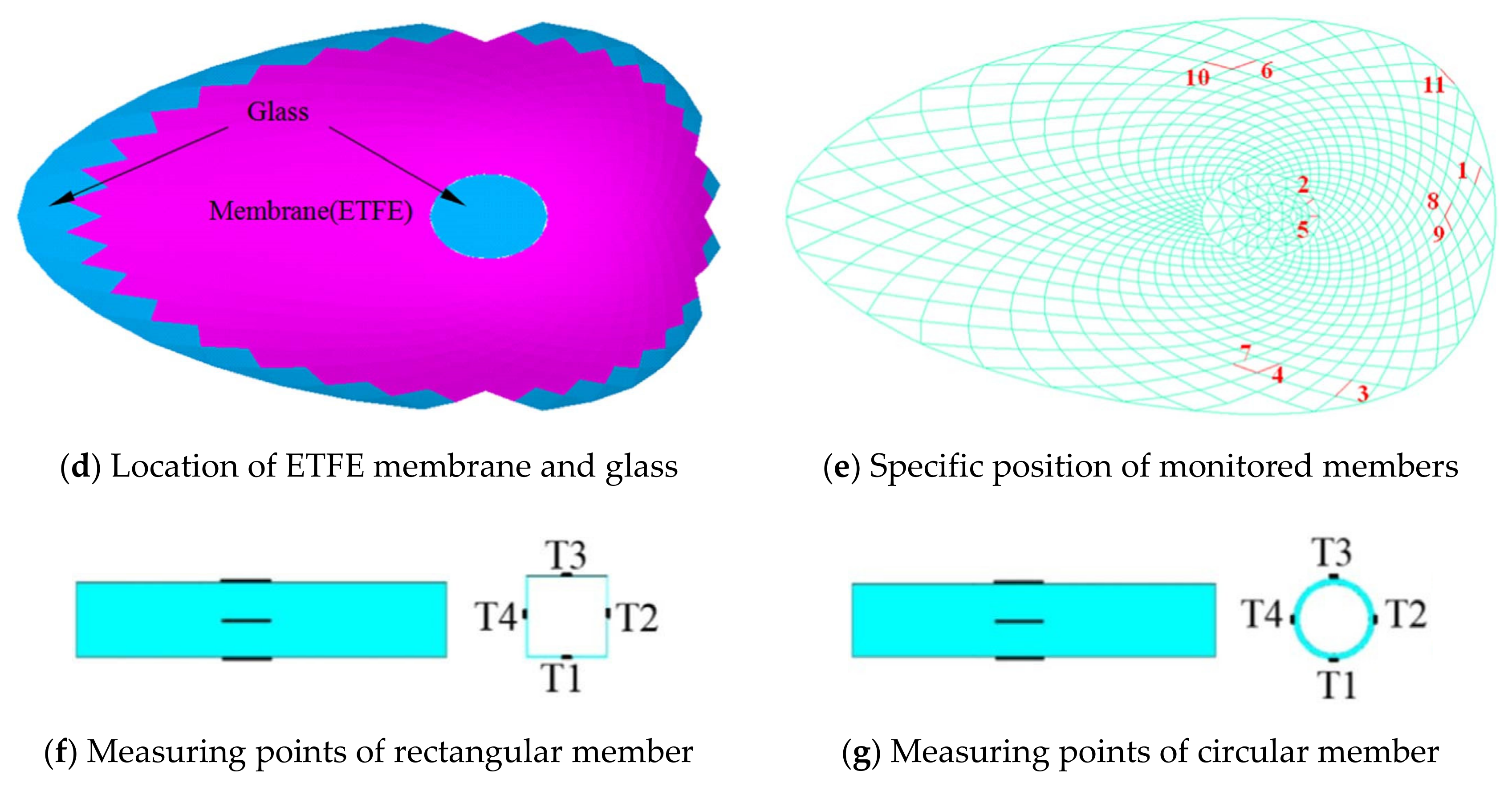
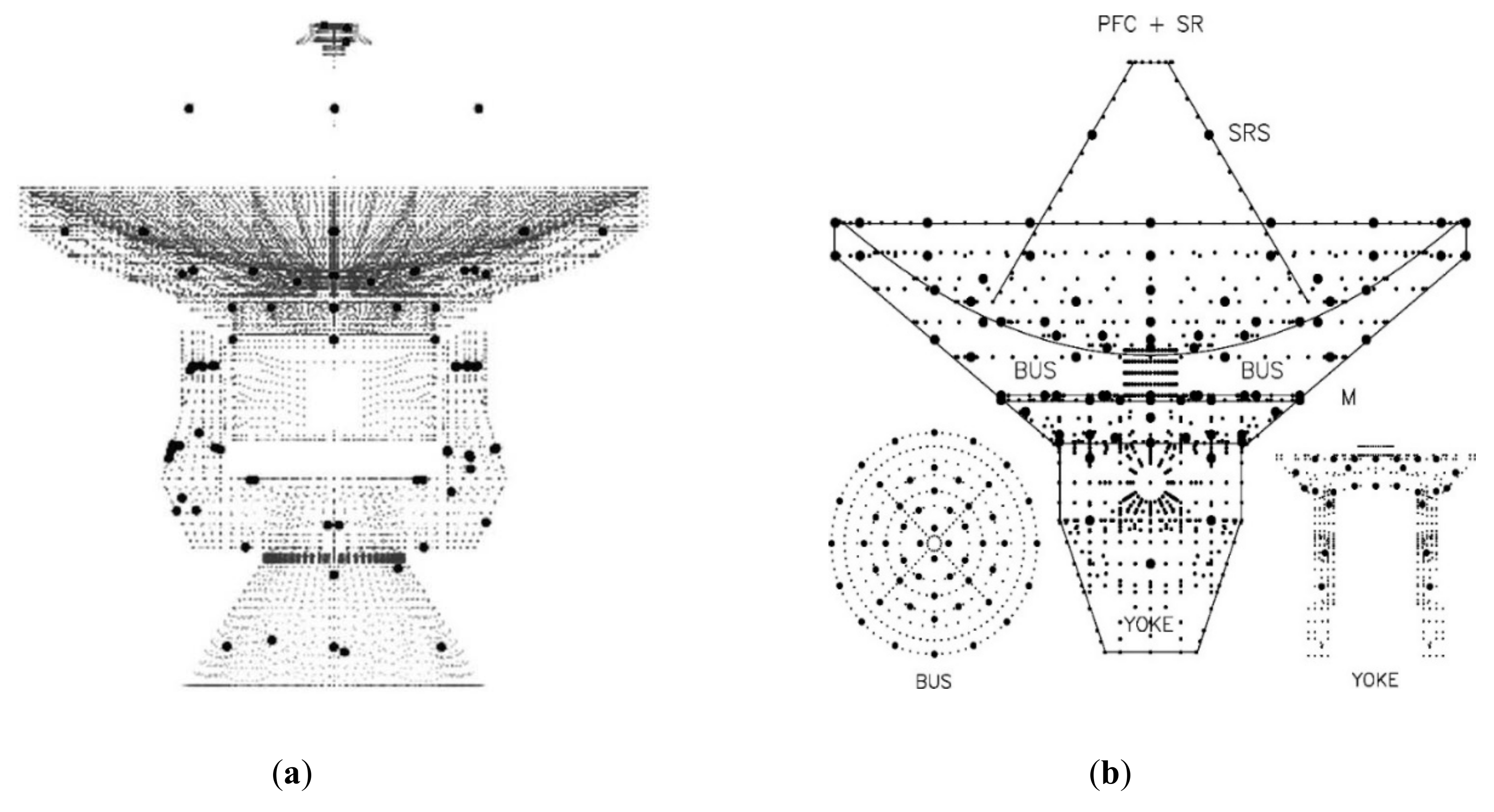
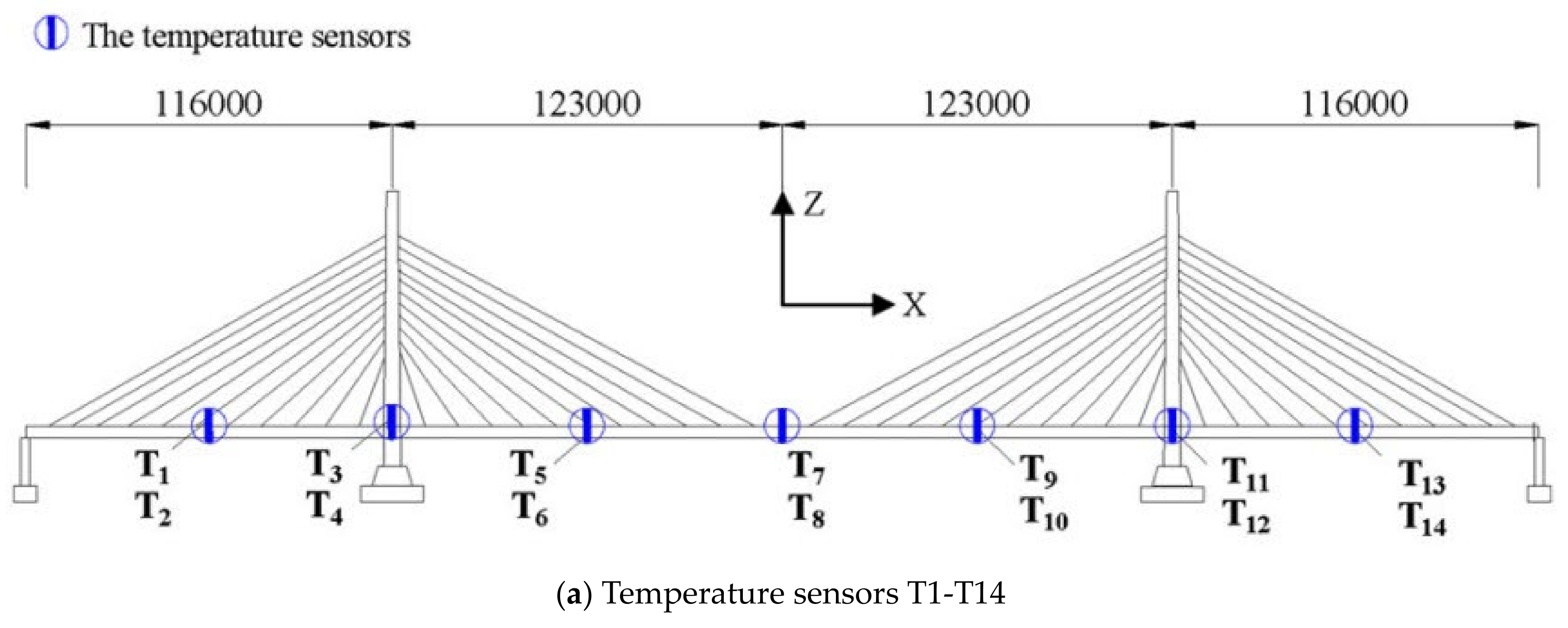
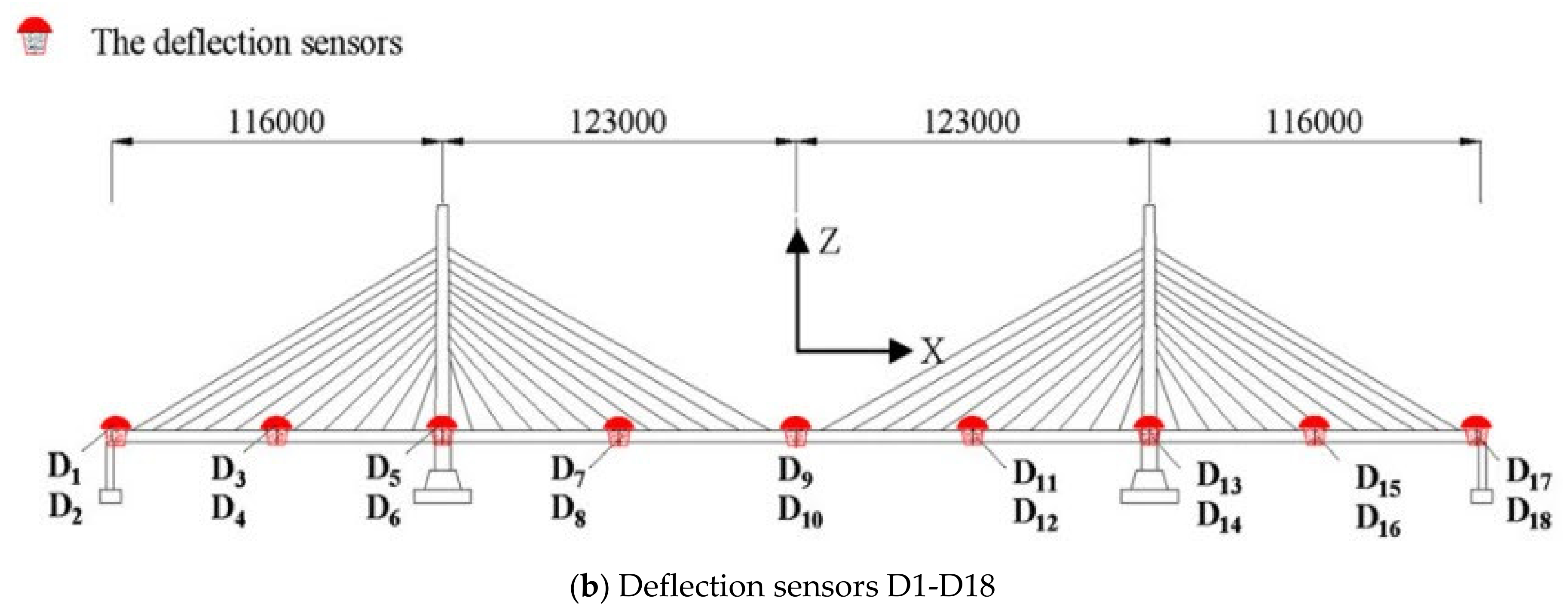

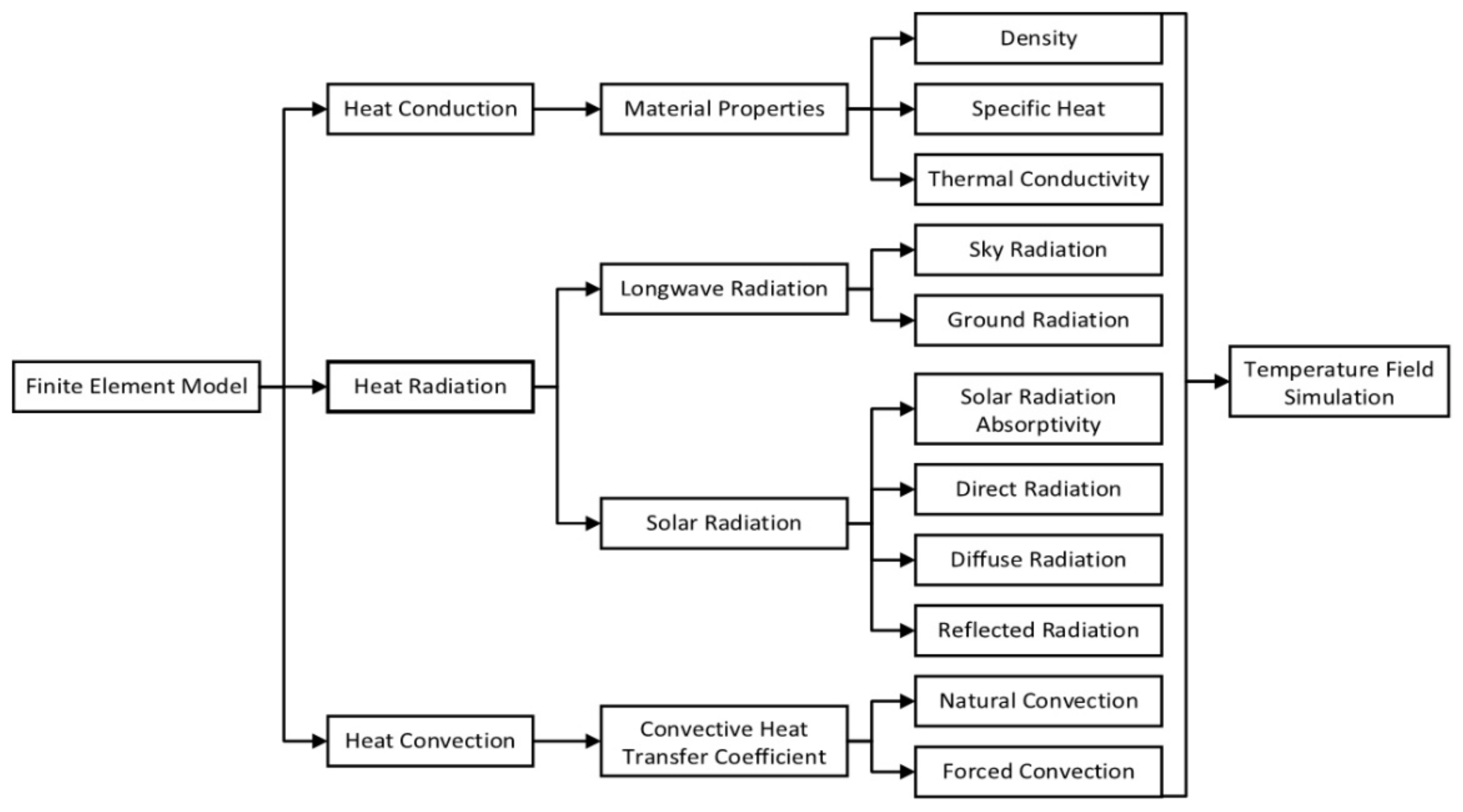
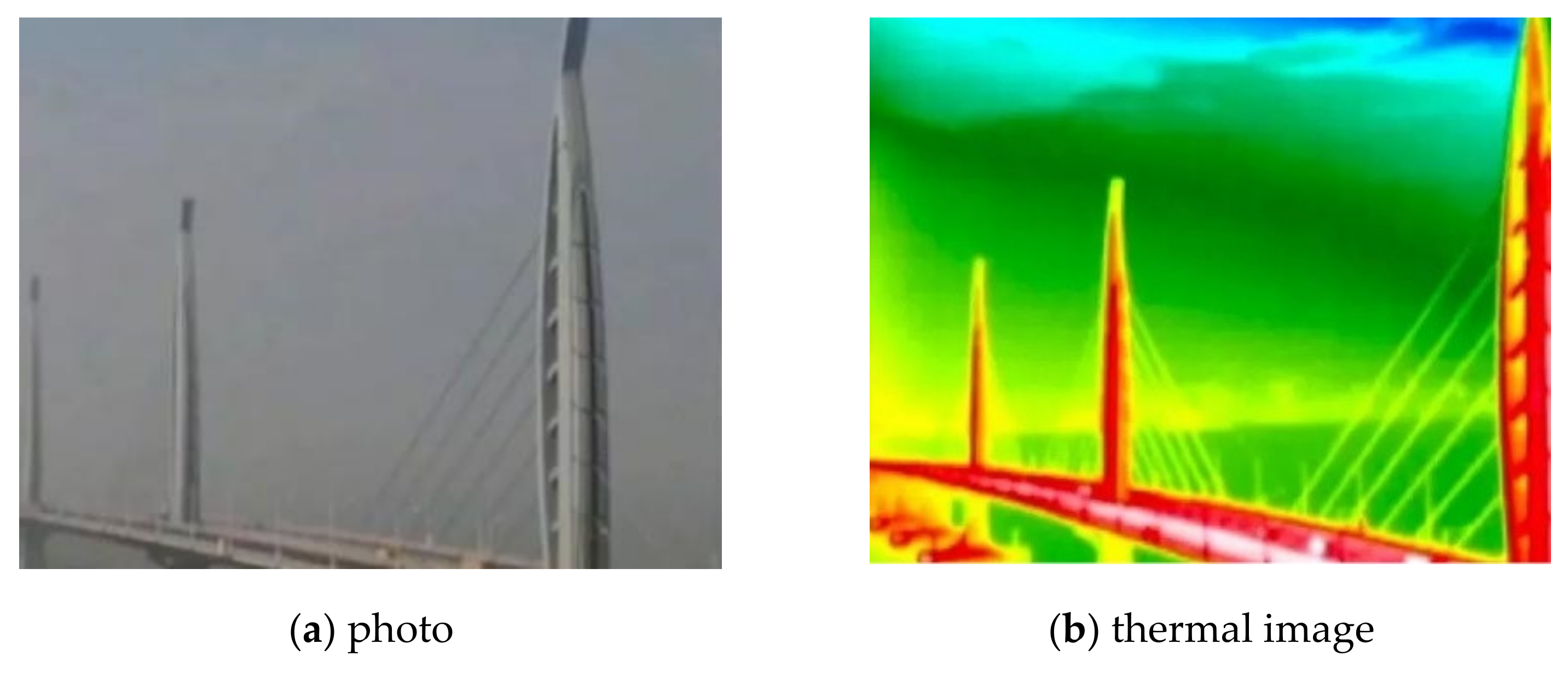
| Number | Expression | Considered Factors | Variables Description |
|---|---|---|---|
| 1 [112] | Wind speed | is convective heat transfer coefficient; , , are the convective heat transfer of the outside surfaces of the top deck, bottom slab and web; is the convective heat transfer of the inside surfaces; is the wind speed; is the wind speed under standard conditions; , are the air temperature and structure surface temperature, respectively; is the temperature difference between the structure surface and air; is Reynolds number; is considered to be the longest dimension size of the panel element as a worst-case condition for convective heat transfer; is the density of air; is the absolute viscosity of air; is Prandtl number; is the heat con ductivity of air; is a heat flow constant, and its value is related to the temperature difference between structure surface and air; is the average air film temperature, and can be approximated by the average of and | |
| 2 [113] | Wind speed | ||
| 3 [114] | for for | Wind speed | |
| 4 [115] | for | Wind speed | |
| 5 [104] | Different parts of box girder, wind speed | ||
| 6 [101] | Temperature difference between the structure surface and air, wind speed | ||
| 7 [95] | Windward: Leeward: | Windward and leeward, Temperature difference between the structure surface and air, wind speed | |
| 8 [92] | For a flat surface of total length L, Laminar flow: turbulent flow: | Fluid state, wind speed | |
| 9 [116] | Average temperature and temperature difference between the structure surface and air, wind speed |
| Bridge | Number of Test Sections | Number of Measuring Points | Test Time | Test Area |
|---|---|---|---|---|
| Incheon Bridge [123] | 1 | 7 | June, from September to November, 2008 | Incheon, South Korea |
| Layout of measuring points at the cross-section | ||||
 | ||||
| Sutong Bridge [124] | 1 | 8 | From January to December, 2011 | Jiangsu, China |
| Layout of measuring points at the cross-section | ||||
 | ||||
| Nanxi Yangtze River Bridge [125] | 1 | 15 | From August 1 to December 1, 2014 | Sichuan, China |
| Layout of measuring points at the cross-section | ||||
 | ||||
| Normandy Bridge [51,52] | 1 | 12 | From February, 1996 to December, 1998 | Normandy, France |
| Layout of measuring points at the cross-section | ||||
 | ||||
| Runyang Bridge [57,126] | 4 | 4 × 8 | From 2005 to 2010 | Jiangsu, China |
| Layout of measuring points at the cross-section | ||||
 | ||||
| Radio Telescope | Reflector Diameter (m) | Measured Component | Number of Sensors |
|---|---|---|---|
| BIMA [79] | 6 | BUS | 32 |
| ASTE [130] | 10 | BUS, Pedestal, Fork | 170 |
| OVRO [79] | 10.4 | BUS | 48 |
| VertexRSI-ALMA [127] | 12 | Pedestal, Fork, BUS | 89 |
| AEC-ALMA [127] | 12 | Pedestal, Fork | 101 |
| ALMA-J [131] | 12 | BUS | 227 |
| FCRAO [132] | 14 | BUS, Quadripod, Subreflector | 30 |
| JCMT [79] | 15 | BUS, Alidade | 220 |
| IRAM [129] | 30 | Yoke, BUS, Quadripod | 156 |
| NRO [88,89] | 45 | BUS | 140 |
| RT-70 [133] | 70 | BUS | 200 |
© 2020 by the authors. Licensee MDPI, Basel, Switzerland. This article is an open access article distributed under the terms and conditions of the Creative Commons Attribution (CC BY) license (http://creativecommons.org/licenses/by/4.0/).
Share and Cite
Xu, W.; Chen, D.; Qian, H. Non-Uniform Temperature Fields and Effects of Steel Structures: Review and Outlook. Appl. Sci. 2020, 10, 5255. https://doi.org/10.3390/app10155255
Xu W, Chen D, Qian H. Non-Uniform Temperature Fields and Effects of Steel Structures: Review and Outlook. Applied Sciences. 2020; 10(15):5255. https://doi.org/10.3390/app10155255
Chicago/Turabian StyleXu, Wucheng, Deshen Chen, and Hongliang Qian. 2020. "Non-Uniform Temperature Fields and Effects of Steel Structures: Review and Outlook" Applied Sciences 10, no. 15: 5255. https://doi.org/10.3390/app10155255
APA StyleXu, W., Chen, D., & Qian, H. (2020). Non-Uniform Temperature Fields and Effects of Steel Structures: Review and Outlook. Applied Sciences, 10(15), 5255. https://doi.org/10.3390/app10155255



